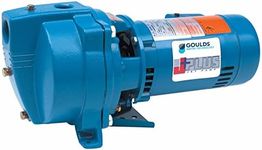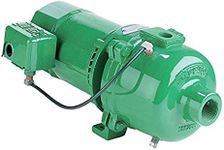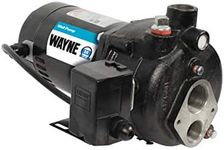Buying Guide for the Best Shallow Well Jet Pumps
Choosing the right shallow-well jet pump is important for ensuring a reliable water supply for your home, garden, or small-scale irrigation needs. These pumps are designed to draw water from wells that are not very deep, typically up to about 25 feet. When shopping for a shallow-well jet pump, it's important to understand the key specifications that affect performance, efficiency, and suitability for your specific needs. By learning what each specification means and how it relates to your situation, you can make a confident and informed decision.Maximum Suction LiftMaximum suction lift refers to the greatest vertical distance the pump can draw water from the water source to the pump itself. This is crucial because shallow-well jet pumps are only effective up to a certain depth, usually around 25 feet. If your well is deeper than this, the pump may not be able to draw water efficiently. To choose the right pump, measure the distance from the pump installation point to the water level in your well. If it's less than the maximum suction lift of the pump, you're good to go. Always allow a small margin for seasonal water level changes.
Flow Rate (Gallons Per Minute or GPM)Flow rate tells you how much water the pump can deliver in a given time, usually measured in gallons per minute (GPM). This is important because it determines how quickly you can fill tanks, run sprinklers, or supply your household. Lower flow rates (5-10 GPM) are suitable for small homes or light garden use, while higher flow rates (10-20+ GPM) are better for larger homes or multiple simultaneous uses. Consider how many fixtures or appliances you want to run at once to estimate your needed flow rate.
Horsepower (HP)Horsepower measures the power of the pump's motor. More horsepower means the pump can move more water or handle higher pressure, but it also uses more electricity. For most shallow wells, pumps range from 0.5 to 1.5 HP. Smaller homes or gardens can usually get by with 0.5 to 1 HP, while larger homes or those with higher water demands may need more. Match the horsepower to your flow rate and pressure needs, but avoid oversizing, as it can lead to unnecessary energy use.
Pressure Switch SettingsThe pressure switch controls when the pump turns on and off, based on the water pressure in your system. Common settings are 30/50 psi or 40/60 psi, meaning the pump starts at the lower number and stops at the higher. Higher pressure settings provide stronger water flow at faucets but may require a more powerful pump. Choose a setting that matches your household needs and plumbing system, keeping in mind that higher pressure can be more comfortable for showers but may stress older pipes.
Material and Build QualityThe materials used in the pump's construction affect its durability and resistance to corrosion. Common materials include cast iron, stainless steel, and thermoplastic. Cast iron is sturdy and long-lasting, stainless steel resists rust, and thermoplastic is lightweight and corrosion-resistant but may not be as durable. If your water has high mineral content or you live in a humid area, prioritize corrosion resistance. For long-term reliability, choose a pump with solid build quality and materials suited to your environment.
Voltage and Power RequirementsShallow-well jet pumps are available in different voltage options, typically 115V or 230V. The right choice depends on your home's electrical system. Some pumps are dual-voltage and can be wired for either. Make sure your power supply matches the pump's requirements to ensure safe and efficient operation. If you're unsure, consult an electrician or check your existing pump's setup.
Self-Priming CapabilitySelf-priming means the pump can remove air from its system and start pumping water without manual intervention. This is important for ease of use, especially if the pump is likely to lose its prime due to air leaks or occasional dry runs. Most modern shallow-well jet pumps are self-priming, but it's good to confirm this feature for convenience and reliability, especially if you don't want to deal with manual priming.














